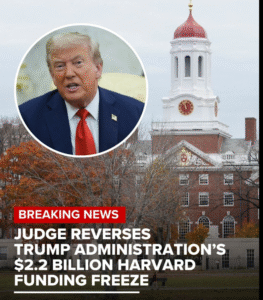The Freeze That Failed: How Harvard Fought Back Against Trump’s $2.2 Billion Funding Cut
On September 3, 2025, U.S. District Judge Allison Burroughs issued an 84-page ruling that sent shockwaves through academia and politics alike: the Trump administration’s attempt to freeze $2.2 billion in federal research funding to Harvard University was unlawful. The judge vacated all freeze orders and termination letters issued since April 14, declaring them unconstitutional and procedurally invalid.
It was a victory for Harvard—but a complicated one. Because while the court protected the university’s funding and academic freedom, it also acknowledged a painful truth: Harvard had failed to adequately address antisemitism on its campus.
🧠 The Origins of the Freeze
The funding freeze began in April 2025, when the Trump administration accused Harvard of tolerating antisemitic behavior, particularly during campus protests related to Israel’s war in Gaza. The administration’s Joint Task Force to Combat Anti-Semitism alleged that Jewish and Israeli students were being harassed, and that Harvard had done little to intervene.
In response, the administration froze $2.2 billion in federal grants and $60 million in contracts—money that supported over 900 research projects, including studies on Alzheimer’s, cancer, heart disease, autism, and suicide prevention among veterans.
Harvard sued immediately, arguing that the freeze was politically motivated and violated the First Amendment. The American Association of University Professors joined the legal challenge, and the cases were consolidated in Boston federal court.
🔍 The Judge’s Ruling
Judge Burroughs didn’t mince words. She ruled that the Trump administration had “used antisemitism as a smokescreen” for a targeted, ideologically driven assault on elite universities. She wrote:
“We must fight against antisemitism, but we equally need to protect our rights, including our right to free speech, and neither goal should nor needs to be sacrificed on the altar of the other.”
Burroughs emphasized that while Harvard had acknowledged antisemitism on campus and could have handled it better, the administration’s funding cuts had little to do with solving that problem. Instead, they were part of a broader campaign to “unwoke” academia and punish institutions perceived as liberal strongholds.
She concluded:
“There is, in reality, little connection between the research affected by the grant terminations and antisemitism.”
🔥 The Political Undercurrents
Trump’s battle with Harvard was never just about antisemitism. It was about control. About reshaping higher education. About forcing elite institutions to submit to federal oversight on curriculum, staffing, admissions, and “viewpoint diversity”.
The administration had demanded that Harvard audit its ideological balance, revise its governance structure, and limit international student enrollment. When Harvard refused, the funding freeze followed.
Judge Burroughs saw through it. She accused the administration of violating the Administrative Procedure Act, Title VI of the Civil Rights Act, and the First Amendment.
And she made it clear: the government cannot weaponize funding to silence dissent or enforce ideology.
🧵 The Cost of the Freeze
Harvard’s research programs suffered. Hiring was halted. Projects were paused. Public health initiatives were jeopardized. Experts warned that lives could be lost due to delays in medical breakthroughs.
The university’s reputation took a hit. So did its ability to attract international students, who make up 27% of its enrollment and contribute significantly to its revenue.
But the biggest cost was moral. Harvard had to confront its own failures. In court filings, the university admitted that antisemitism had been a problem. That Jewish students felt unsafe. That the administration had been slow to respond.
Judge Burroughs acknowledged this:
“Harvard was wrong to tolerate hateful behavior for as long as it did.”
It was a moment of reckoning. For Harvard. For academia. For the country.
🕊️ The Broader Implications
This ruling doesn’t just affect Harvard. It sets a precedent. It sends a message to every university, every federal agency, every administration: academic freedom is protected. Funding cannot be used as a political weapon. And the courts will intervene when constitutional lines are crossed.
It also raises questions about how universities handle hate speech, protest, and ideological diversity. Harvard may have won the legal battle—but it must now win back trust. From students. From faculty. From the public.
And it must do so without compromising its values.
💡 What We Learn
From this case, we learn that power must be checked. That even a president cannot override the Constitution. That courts matter.
We learn that antisemitism is real—and must be confronted. But not exploited.
We learn that universities are vulnerable. That their funding, their freedom, their integrity can be threatened. And that they must be vigilant.
We learn that truth is layered. That Harvard was both victim and culprit. That justice can be complicated.



